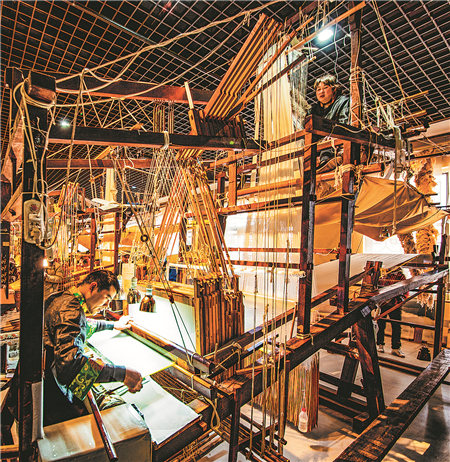

Among China's myriad forms of silk products, one of them — yunjin — remained shrouded in mystery for more than a millennium. Historically reserved exclusively for imperial use, its intricate techniques were passed down from generation to generation within the family lineages of select artisans.
Ancient Chinese granted it a name befitting its sublime nature, yun meaning clouds and jin meaning brocade. Just like clouds in the sky, the fabric has an iridescent sheen owing to its unique weaving technique and refined raw material.
With the dedication of generations of artisans, who sit at the gigantic weaving looms for hours on end, their fingers dancing among the intricate threads, the craftsmanship of yunjin brocade has been preserved, so that today, its beauty can still be appreciated in all its splendor.
Zhou Shuangxi, a national-level inheritor of the yunjin brocade weaving technique, is one of them.
Having devoted the past five decades to yunjin production, he has honed his expertise to the point where he can both replicate the antique imperial dragon robes in all their minutiae, and also skillfully represent other art forms such as replicating the painting Mona Lisa.
However, Zhou recalls that before he entered the Nanjing Yunjin Research Institute in Nanjing, Jiangsu province, he had no idea what yunjin even was. Back in 1973, he graduated from a mining school, and was selected to become an apprentice of the craft at the institute, probably because it looked like he was "in good shape".
Zhou, along with around five other apprentices, faced a bleak picture at that time, with only several masters in their 70s and not even a loom at their disposal.
"The old masters eventually remembered that there was a loom stored away somewhere. When we opened the storehouse door, what I saw seemed like a pile of firewood. We assembled it into a loom 3 to 4 meters tall, and I finally saw for the first time what a traditional yunjin loom looked like," Zhou recalls.
The teachers were masters of the craft, and they taught the apprentices the traditional methods, from handling the fragile threads to using mnemonic rhymes to help them acquire the technique.
"It was difficult, but in a different way from mining. Mining requires heavy physical labor, but working with the soft and thin silk requires patience. My hands were calloused from mining, so I used to soak my hands in warm water whenever I could, so that they could become softer and make it easier to reel the silk," he says.
Out of the six or so apprentices, Zhou is the only one who has persevered in the trade until this day. He participated in 1983 in the replication of an antique dragon robe unearthed from the Dingling Mausoleum in Beijing, and since then has continued to work on significant projects to replicate cultural relics.
"I am lucky to be in such a good era. All of my teachers were top-notch craftsmen and I was granted governmental funding to learn the technique. I now have the honor of being a representative inheritor," Zhou says.